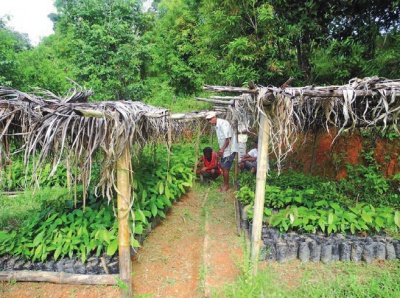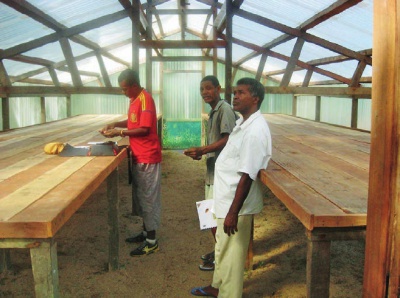From Swiss Chocolate to Cacao Plantations in Madagascar
Four years ago, François Stahl produced 100 percent Swiss chocolate with cacao fruits from the Masoala Rainforest of the Zurich Zoo - the first chocolate made of Swiss cacao. This year, the second round of the "Sélection Masoala" is introduced. The proceeds of the sale are used for a project in Madagascar which supports farmers in planting and maintaining cacao plantations.
Text by Sandra Boulos
A couple of years ago François Stahl could never have imagined what would emerge from a handful of cacao beans and a family tradition. Today, he sits in a coffee shop in the Swiss town of Wallisellen, and talks with enthusiasm about a new project in Madagascar and his trip to this island next year. But first things first. It all began ten years ago, following a family tradition; François Stahl and his wife planted around a dozen cacao beans in honour of their daughter's birth. Shortly afterwards, the couple donated the plants to the Masoala Rainforest of the Zurich Zoo. Within a few years, they flourished to magnificent cacao trees, bore fruits and were harvested. But what do you do with Swiss cacao fruits? The chocolate expert François Stahl did not think twice: chocolate! But not any kind of chocolate - no, the first pure Swiss chocolate with all ingredients originating from this country. The chocolate made headlines, was sold, and the proceeds were used for a good cause. Four years later, François Stahl reports on the project that was initiated with the proceeds, a project which goes far beyond the production of Swiss chocolate.
Quality training for farmers
The proceeds from the "Sélection Masoala" - a total of 30,000 Swiss Francs - were used to build an archetype cacao plantation and a fermentation centre on the Peninsula of Masoala in Madagascar. The curator of the Zurich Zoo, Martin Bauert, developed the business plan of the project and now coordinates the enterprise. The team Bauert - Stahl found support in the Swiss Embassy in Madagascar, and in the "Friends of Masoala" Association, the Zurich Zoo and the Wildlife Conservation Society.
"We have been planting cacao trees in Madagascar at full speed for a year now," Stahl is pleased to report. The trees are not only planted, bred, and maintained though; moreover, their crop is to be used for the production of chocolate. Here is where François Stahl comes into play. As head of development of the Wallisellen-based chocolate production company "Chocolats Halba", he knows what it takes to produce good, high-quality chocolate, and he wishes to pass on his knowledge to Madagascan farmers. Part of his training for the farmers focuses on the procedure of "fermentation"; in this multi-day process, the core of the fruit - the cacao beans - and the fruit pulp are poured into boxes that are lined with banana leaves. Yeast naturally occurring on the banana leaves breaks down the sugar in the fruit pulp; thus, the cacao beans heat up to 45 degrees and get fermented. And this is how the pre-stage of the cacao flavour is developed. "Fermentation builds the basic taste," explains chocolate expert François Stahl. "It is the name of the game of chocolate production."
How long should the process of fermentation take? What are the ideal preconditions? And how should the approach be adapted to the conditions in Madagascar? Stahl sends his instructions by email to Madagascar. The Madagascan environment, however, is new territory for him. "With the weather conditions that I am not familiar with, this is a big challenge," says Stahl. He sends guidelines to the farmers; they go through a checklist, and record temperatures and weather conditions which they report back to him. This in turn helps him to analyse and improve the process. "The quality of the first crop was very poor," laughs the chocolate expert. No chocolate could be produced from it. Nevertheless, explains Stahl, thanks to an improved process already in the next harvest the Madagascan farmers achieved a "quantum leap forward compared to the first sample".
Securing the retirement pension of farmers
The aim is to attract up to two hundred farmers for the project within the next five years. Every farmer is expected to plant around a thousand trees, which corresponds to one hectare of land. So far, around thirty Madagascan farmers participate in the reforestation. "We supply them with the material," says Stahl and adds that the main work still lies with the locals. "They provide their fields and invest their work for five years." By building a cooperative, farmers are encouraged to jointly carry out the fermentation, and become independent. The procedure of fermentation only pays off with large amounts of cacao beans. As an interim solution for the first five years, the farmers are ensured that their crop gets purchased. Within this time, the aim is to achieve a fair trade label, acquire an organic certification, and to improve the production of cacao to that extent that delicious chocolate can be produced. This could then be sold on the market.
To support the farmers on the long run, other local woods are planted as well. These tree species do not only provide shade; their roots are also a source of nitrogen for the cacao trees. And in thirty years, these forest trees will become a source of valuable income. "This is so to speak the old-age pension for a farmer," explains Stahl. For project coordinator Bauert and chocolate expert Stahl, the important point is not only that the farmers secure their income, but that the participants in the project also develop an interest in protecting the rainforest.
Step by step to the project
By now, François Stahl has already invested countless hours into the project. To support the project further, he founded the company "Cacaotree". He sees the volunteering work with chocolate as a hobby and the development of the project fills him with satisfaction: The idea started from scratch, evolved and eventually came to realisation. "Every step is fascinating; you realize what you can effect and move. We can show farmers, who have nothing, a future," he says. "In the end, they do the work. It's not only about giving; it's more about accompanying and supporting them." He continues with a smile: "I like investing my time into such a project." Next year, François Stahl will visit Madagascar for the first time, a trip he is very much looking forward to.
Second "Sélection Masoala"
At the same time the 100 percent Swiss chocolate is back in the spotlight. This year again, François Stahl produced the sweet confectionery, thanks to the crop of the four to five meter high cacao trees in the Masoala Rainforest of the Zurich Zoo. Just as four years ago, all the ingredients come from Switzerland. "This time it's a dark chocolate," says Stahl. The second "Sélection Masoala", a chocolate in the form of a small cacao fruit, can be purchased at the Zurich Zoo for 50 francs. 320 pieces - a total of 1.4 kilograms - were launched at the Madagascar days of the Zoo, on the 4th and 5th of October. The proceeds will flow again into the project in Madagascar. The story of chocolate continues to be written.
The Masoala Rainforest at Zurich Zoo
The Masoala Rainforest is a specially designed hall in the Zurich Zoo which imitates the rainforest in Madagascar. The tropical oasis in the Zoo covers an area of some 11,000 square meters. It includes approximately 17,000 plants and trees and 430 animals. Visitors can walk around the hall and observe the plants and the animals which jump, fly and crawl around freely. The Masoala Rainforest of the Zoo Zurich opened in 2003 and is the centrepiece of the zoo's nature conservation strategy.
This is an English translation of the original German language article titled Von Schweizer Schoggi zu madagassischen Kakaoplantagen published on 16th October 2014 in the Swiss publication Anzeiger von Wallisellen.




